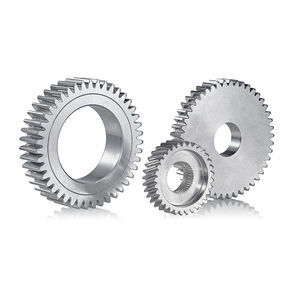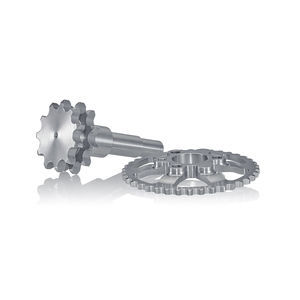
- Power Transmission - Mechanical components
- Mechanical Transmission
- Spur gear
- Zahnradfabrik Hänel GmbH & Co. KG

- Products
- Catalogs
- News & Trends
- Exhibitions
Spur gear helicalstainless steelfor shafts


Add to favorites
Compare this product
Characteristics
- Type
- spur
- Teeth
- helical
- Material
- stainless steel
- Applications
- for shafts
- Other characteristics
- precision
Description
Pump gears are generally used in feed pumps. They can pump various media, depending on their design. Due to requirements for leakproofness, they require high-precision pump gears. A pump gear is a central component in feed pumps. The gear transmits mechanical energy from the pump shaft to the liquid to be pumped.
The rotational movement of the gear creates low pressure that draws the liquid medium into the pump, which is why this type of pump is also called a self-priming gear pump. When the liquid is inside the pump housing, the rotary motion presses it against the mating gear. The gear’s speed of rotation plays a key role in the delivery rate. The shape and size of the gearing also determines the type and power of the flow as the liquid exits the pump. The quality of the pump is largely determined by the leakproofness of the gear pump housing. The pump gears’ radial eccentricity and linear movement tolerances are key and are often restricted to a few thousandths of a millimeter.
The pump’s performance requirements determine the material from which a pump gear is made. The composition of the liquid to be pumped determines the metallurgic factors that apply when choosing the gear material. Chemicals and corrosive media often have a tremendous influence. Also, frequent changes in temperature must not cause the gear material to be permanently deformed over the course of its service life.
In most cases, stainless steel is used in manufacturing in order to guarantee a long service life and high quality. To achieve maximum performance and the longest possible service life, pump gears are also hardened or provided with wear-protective coatings such as tungsten carbide.
Other Zahnradfabrik Hänel GmbH & Co. KG products
Products
Related Searches
- Straight-toothed sprocket wheel
- Chain sprocket wheel
- Helical gear
- Spur gear
- Metal sprocket wheel
- Steel sprocket wheel
- Precision shaft
- Shaft gear
- Cylindrical gear
- Precision gear
- Single shaft
- Transmission shaft
- Transmission gear
- Stainless steel sprocket wheel
- Internal-toothed gear
- Stainless steel gear
- Drive shaft
- Single sprocket wheel
- Triple sprocket wheel
- Flange sprocket wheel
*Prices are pre-tax. They exclude delivery charges and customs duties and do not include additional charges for installation or activation options. Prices are indicative only and may vary by country, with changes to the cost of raw materials and exchange rates.









